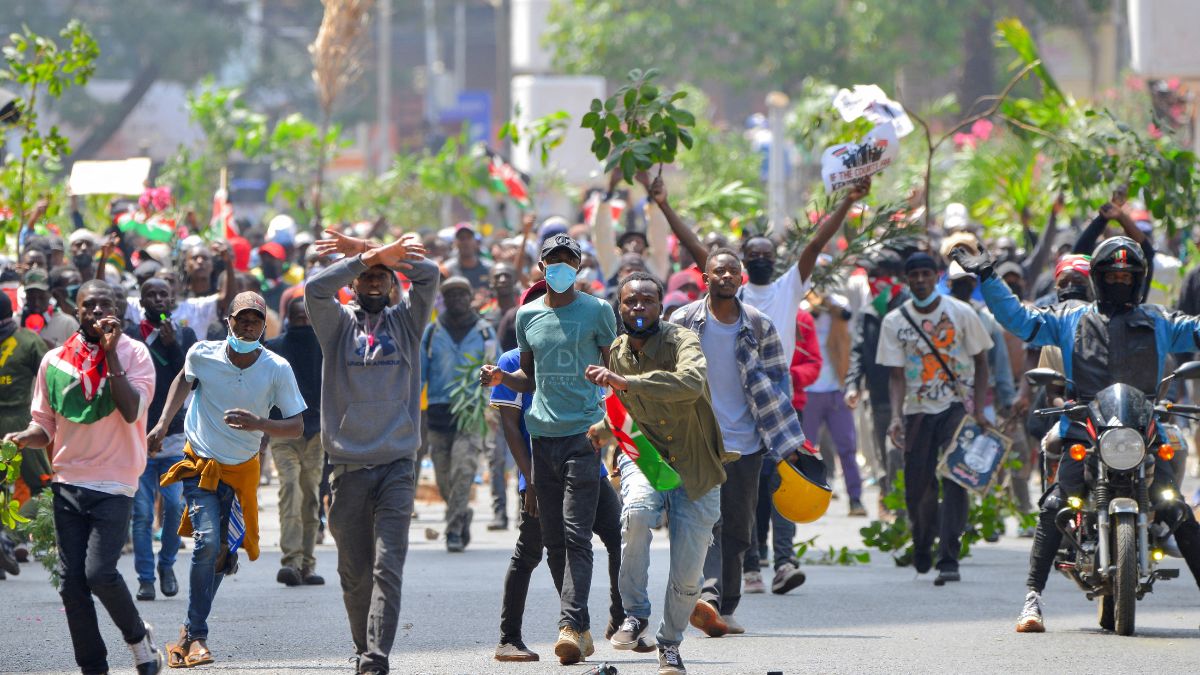Kenya is once again witnessing large-scale protests. Thousands of demonstrators took to the streets on Wednesday (June 25) to mark the one-year anniversary of protests against a tax bill that had turned deadly.
Reports have emerged that at least two people were killed and eight others were hospitalised with gunshot injuries after being allegedly shot by police during the rallies in Matuu, around 100 kilometres from the capital.
Let’s take a closer look.
Why Kenyans took to the streets in 2024
Last year, Kenyan youth, referred to as Gen Z, organised protests for weeks to oppose the government’s controversial Finance Bill 2024 that would have raised taxes.
On June 25, 2024, protesters breached barriers to storm Parliament and set off a part of the building on fire as lawmakers fled. Police fired at protesters, leaving at least 60 people dead and 20 others missing.
The protests then turned into a call for justice and accountability for good governance in the East African country. Demonstrators called for the resignation of the Kenyan president, William Ruto.
This led to Ruto scrapping the finance bill that proposed tax increases and reshuffling his cabinet to incorporate opposition figures.
However, a recent survey revealed that most of the Kenyans are against this unity government.
ALSO READ: From data to diapers: What pushed angry Kenyans to burn part of parliament
Why Kenyans have returned to streets
Thousands of people staged protests in Nairobi and other Kenyan cities earlier on Wednesday to commemorate the one-year anniversary of youth-led anti-tax demonstrations.
Police barricaded all roads leading to the State House, President Ruto’s official residence, and Parliament in the capital with razor wire. Waving Kenyan flags and holding placards of protesters killed last year, demonstrators chanted “Ruto must go”.
“I’ve come here as a Kenyan youth to protest, it is our right for the sake of our fellow Kenyans who were killed last year. The police are here … they are supposed to protect us, but they kill us,” Eve, a 24-year-old woman, told the AFP news agency.
“It is extremely important that the young people mark June 25th because they lost people who look like them, who speak like them… who are fighting for good governance,” Angel Mbuthia, chair of the youth league for the opposition Jubilee Party, added.
“We are fighting for the rights of our fellow youths and Kenyans and the people who died since June 25… we want justice,” Lumumba Harmony, a protester, told Reuters in Nairobi.
The latest protest comes as anger in Kenya grows over police brutality. Earlier this month, 31-year-old teacher and blogger, Albert Ojwang, died in police custody after being arrested for reportedly criticising a senior police official on social media.
Six people, including three police officers, were charged with murder on Tuesday over his killing. All of them have pleaded not guilty.
Last week, an officer shot a vendor, Boniface Kariuki, at close range during a series of protests triggered by Ojwang’s killing. This further fuelled public anger against the authorities.
Recent protests have been “infiltrated” by men whom protesters say are hired “goons” to disrupt peaceful demonstrations by beating and robbing people.
Mikhail Nyamweya, a political analyst, told The Guardian that the trust in government among many Kenyans, especially younger people, remains low and they see the administration as “unresponsive and detached from everyday struggles”.
“Despite promises of reform, the Kenyan youth view the state as incapable of delivering and always quick to suppress dissent through coercive means,” he said. “Continued reports of human rights violations and inadequate accountability have reinforced the perception that little has changed.”
Speaking to Associated Press (AP), a protester, Rose Murugi, said the police were part of the problem, adding, “We will say it boldly, we will say it courageously, police brutality must end and Ruto must go.”
Kenya Police clash with protesters
Demonstrators clashed with the police as demonstrators hit the streets in Nairobi and other major cities, including Mombasa, Kisumu, Nakuru and Nyahururu. According to Kenya’s biggest newspaper, the Daily Nation, protests erupted in at least 20 of the country’s 47 counties.
Police resorted to water cannons and tear gas to disperse protesters in the Kenyan capital. They also stopped vehicles heading towards the central business district, Reuters reported, citing local TV stations.
As protests spread to other cities, the Communications Authority of Kenya banned live broadcasts and radio coverage of the demonstrations.
The move drew criticism from Kenyan media, with the country’s association of editors saying live coverage is not a threat but a “civil duty to ensure accountability and transparency”.
“We urge all media to stand firm and respect the 2023 High Court ruling that barred such censorship,” the Kenya Editors’ Guild said in a statement on X.
As per an AP report, a protester was injured in the mouth after the police fired a round towards the crowd. Another was struck in the head by anti-riot police and taken by medics in an ambulance.
The National Police Service Commission (NPSC), the state body that employs Kenyan police officers, has urged the cops to uphold the “highest standards of professionalism and restraint”.
It said it had noticed “with concern and keen attention the unfolding situation” and called for “empathy and cooperation” between citizens and the police, reported BBC.
The hashtag #OccupyStateHouse is trending on X, a provocative call for protesters to march to the official residence of the president in Nairobi. The authorities have already warned against any such move.
With inputs from agencies


)

)
)
)
)
)
)
)
)



